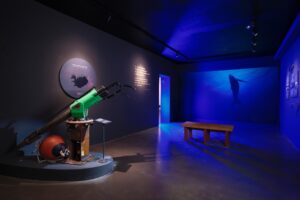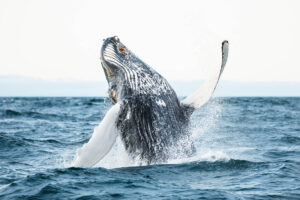Dear readers,
Whalecome at the introduction of the whales of Skjálfandi bay part 5. After the blue whale and the porpoise, the minke whale and the white-beaked dolphin lets introduce the humpback whale, the most commonly seen whale in Skjálfandi bay!
Latin name: Megaptera novaengliae
Common name: humpback whale
Icelandic name: Humpback
Average life span: 50 years
Diet: krill and small schooling fish
Size: 13 – 17 meters
Weight: 25-45 tonnes
Humpback whales are one of the largest whales, with males reaching lengths of 14 meters and females reaching lengths of 17 meters, about the size of a school bus. The pectoral flippers are a third of their body length and can reach a length of 6 meters. Humpback whales are active swimmers and can be seen breaching, tail slapping and flipper slapping. It is theorized that the breaching and tail/flipper slapping is a way of communicating with each other, but may also be used to show dominance and health during the mating season. Humpback whales also use vocalization to communicate with each other, males are known to sing during the mating season. A song can last up to 30 minutes and can be heard from over 30km away.
The year of the humpback whale is split up in 2 sections feeding and breeding. During the summer humpback whales can be found in colder nutrient rich waters like Iceland, Norway and Canada, where they feed on krill. During the winter the humpback whales can be found in warmer waters around the equator like the Caribbean. Here the humpbacks mate and give birth. The gestation period of humpback whales is 11 months. When a calf is born its 4,5 meters in size and weighs 900kg. Calves can drink up to 600L of milk per day. Mother and calf communicate with each other through whispering, this is so that they cannot be overheard by predators such as orca's (killer whale).
Humpback whales are baleen whales and thus use filter feeding to feed. Humpback whales are known to use several techniques to feed, one of these techniques is bubble net feeding. With bubble net feeding a humpback whale blows air from the blow hole trapping the fish and krill to the surface and then feeds on the fish and krill. Humpback whales dive on average around 5 to 10 minutes, but up to 40 minutes have been recorded. When humpback whales are traveling they swim between 5-15 km/h, when feeding they slow to a 2-5,5 km/h, the max speed they can reach is 25km/h.
Humpback whales can be seen in Skjálfandi Bay for a great majority of the year, although their prime season is in the summer months.


